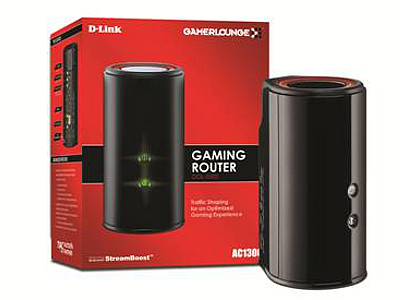D-Link Shipping Gaming Router with StreamBoost in August
This router uses Qualcomm's StreamBoost technology to prioritize specific apps and games.
D-Link said that its upcoming gaming-focused network router, the DGL-5500, will begin shipping on August 1. Customers located in the States can pre-order the device now at Newegg.com for $199.99 USD.
The DGL-5500 is a dual-band router providing wireless speeds up to 867 Mbps on the 5 GHz band for Wireless AC devices, and up to 450 Gbps on the 5 GHz channel for Wireless N devices. The router is based on Qualcomm VIVE 802.11ac technology, and features Qualcomm's StreamBoost engine which intelligently manages and shapes traffic, giving each device and application the priority and bandwidth required for optimal performance.
According to D-Link, out-of-the-box support includes Netflix, YouTube, Pandora, VUDU, BitTorrent, StarCraft II and more. In one diagram, the router crams streaming video into one lane, music into another lane, gaming into a third, and general applications like Facebook into a thinner fourth lane. Without StreamBoost, all data gets equal priority, thus causing lag and buffering.
"Unprecedented bandwidth allocation and control features create a harmonious network where applications no longer need to compete for bandwidth, and issues such as buffering video streams, glitchy voice chats and online game latency are minimized," the company said. "The intuitive StreamBoost interface is designed to allow users to view all computers, tablets, phones, and other connected devices on a home network, as well as the applications they are using and the real-time bandwidth usage of each."
The router includes crowd-sourced application profile creation, a cloud-based updating system to ensure that it is constantly up-to-date as new apps and games are released for optimized performance, advanced UPnP support, and four Gigabit Ethernet ports for fast wired gaming. Security features include WPS and Wi-Fi Protected Access (WPA/WPA2). The router's overall size is 9.8 x 6.5 x 2.8 inches.
"The Gaming Router represents the ultimate in high-performance connectivity to give power users the ability and control they need to do what they love online without the concern or interruption of buffering and lag," said Daniel Kelley, vice president of marketing, D-Link Systems, Inc. “With Qualcomm StreamBoost technology, the new Gaming Router is designed to… help gamers do more and lag less."
To pre-order the upcoming Game Router, head over to Newegg here. The actual product page on D-Link's website can be accessed here.
Get Tom's Hardware's best news and in-depth reviews, straight to your inbox.

Kevin Parrish has over a decade of experience as a writer, editor, and product tester. His work focused on computer hardware, networking equipment, smartphones, tablets, gaming consoles, and other internet-connected devices. His work has appeared in Tom's Hardware, Tom's Guide, Maximum PC, Digital Trends, Android Authority, How-To Geek, Lifewire, and others.
